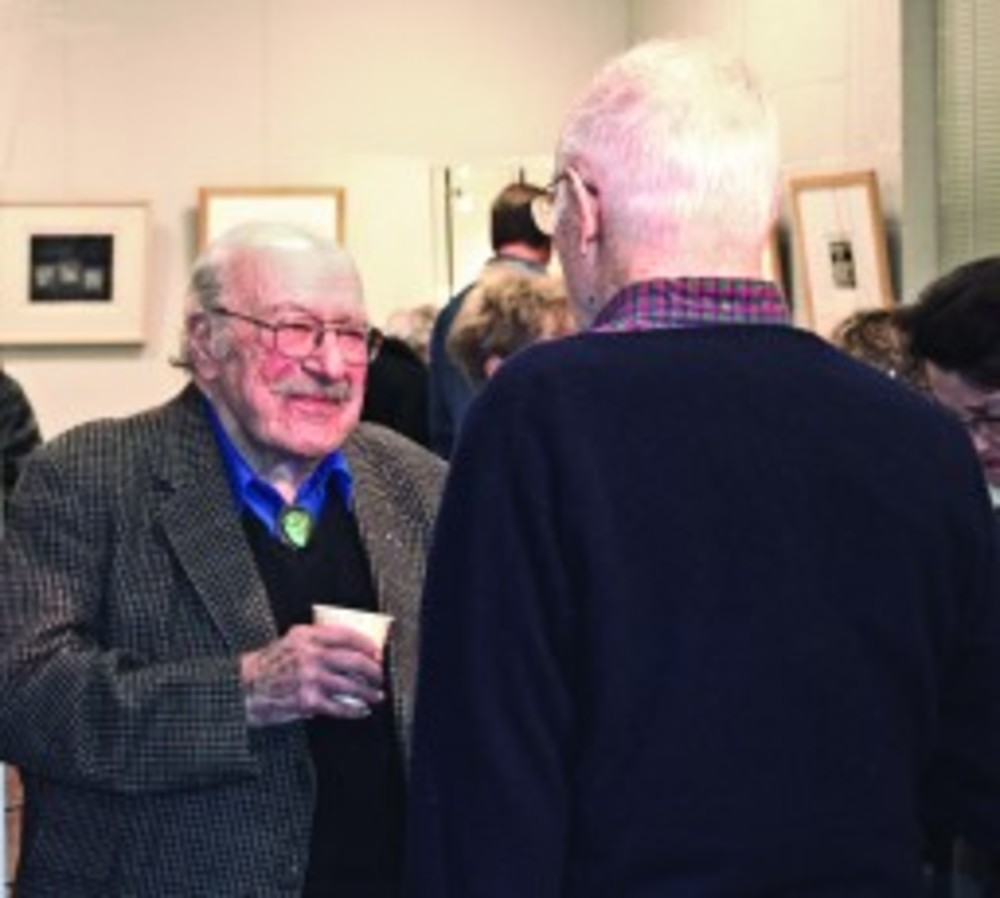Walter Feldman deconstructs himself
Internationally renown artist at gallery (401)
 Walter Feldman, whose show of Recent Works is on display at gallery (401) through Nov.15, spoke in an informal question and answer session about his work on Tuesday, Oct. 29. Feldman, who is quite a raconteur, began by sharing with more than two dozen attendees the setting that informed the small abstract collages in his show. These collages are listed as “Collage and Flame on Canvas” in the sale catalog. As he said, he wanted to let us know how they came about – not only how they were made but also how they were “psychologically born.”
Walter Feldman, whose show of Recent Works is on display at gallery (401) through Nov.15, spoke in an informal question and answer session about his work on Tuesday, Oct. 29. Feldman, who is quite a raconteur, began by sharing with more than two dozen attendees the setting that informed the small abstract collages in his show. These collages are listed as “Collage and Flame on Canvas” in the sale catalog. As he said, he wanted to let us know how they came about – not only how they were made but also how they were “psychologically born.”
As a combat infantryman in 1945, Feldman recalled a cold, icy and windy day as a first scout – a soldier whose role it was to draw enemy fire so that the artillery could know their location. He remembered resting in a Belgian town when his infantry was told to get ready. They spent the next eight hours on a truck and then digging foxholes and waiting until they were under attack. Walter remembers ending up on a field, under a tree and looking up to see a beautiful orange cloud infiltrated by bits of black. His next memory was of being hit by shrapnel, experiencing pain and operations, eventually winding up in a hospital in Britain and discovering, through pain and X-rays, even more shrapnel still lodged in his body.
Of course, he said, the experience of war and injury changes one. Feldman wanted to express some of this experience visually. He found some old canvas that had been prepared with lead white. He discovered that, by manipulating the canvas, cracks appeared which could be used as drawings. Next, he used an acetylene torch with which he could darken and burn holes into the canvas. The burning is symbolic to him of a catastrophic event. His canvasses are abstract so that we, as the viewers, can join our own references to the references which he, as the artist, imagines. Thereby his work depends on the interaction between the two witnesses. This is why he prefers abstract art to representational art in his own work.
After this introduction, members of the audience asked a variety of questions of the artist. People were interested in how he came up with some of the symbols in his work. Feldman said that he takes much time to prepare before he starts a project, such as his mosaic at Temple Emanu-El, by reading and research. He incorporates many meaningful symbols, transformed by his imagination and hand, in his work. He also spent a year in Rome learning the art of mosaics from artisans because it was a new medium for him.
When asked for the influences in his life, he stated that his favorite artists included De Kooning, Kleé and Byzantine artists. Also, he feels that his students have had a profound influence on his life. He mentioned that he is founding a Trust to support young artists in Boston and one of his board members is a student from fifty years ago.
Asked if his Judaism informed his work, Feldman said he didn’t know because he has wide-ranging interests. His father was a socialist uninterested in religion but very interested in being a good person. Feldman said he aspires to also be a good person but not to define his interests in one direction.
Feldman spoke a bit about his work in creating books. In 1990, he found Ziggurat Press, which prints small-edition handmade books. He told the audience about one based on a letter he received while in the trenches. His mother, he said, had been completely illiterate, but she learned to write English so she could send him comfort from home. He made a printing plate of her handwriting and created a book called “A Packet of Letters.” He was clearly proud that copies of this book honoring his mother are in the Museum of Modern Art in New York and the Victoria and Albert Museum in London.
Finally, he was asked if he preferred one medium over others and if he worked in one until he tired of it and moved on. Interestingly, in his answer, Feldman suggested that he based his art life on the Old Masters who were able to create in a number of different media. He revealed that some media don’t interest him personally but if he is interested, he will dedicate time and effort to learning how to use a new material as he had with stained glass and tesserae for mosaics.
Walter Feldman is a Rhode Island treasure and his informative talk transformed his work for the audience while lending insight into how an artist moves from experience to expression. His “Collage and Flame on Canvas” especially gained a deeper significance for me after hearing the personal story that led to their creation. If you haven’t done so yet, take time to view this wonderful show before it closes this month.
Lee Kossin (lkossin@gmail) is an artist residing in Providence.







